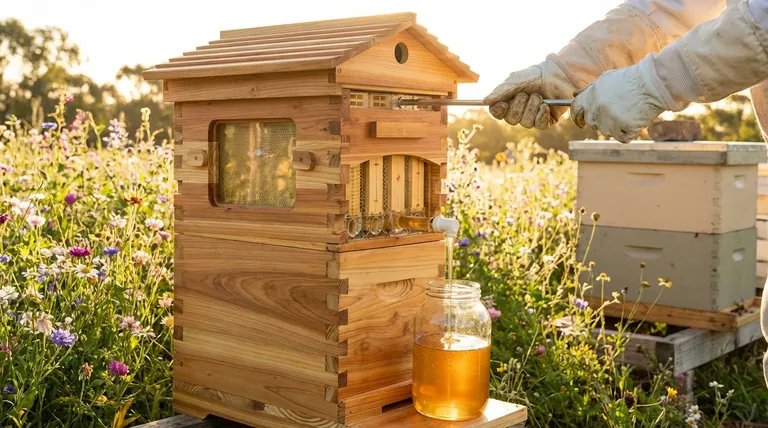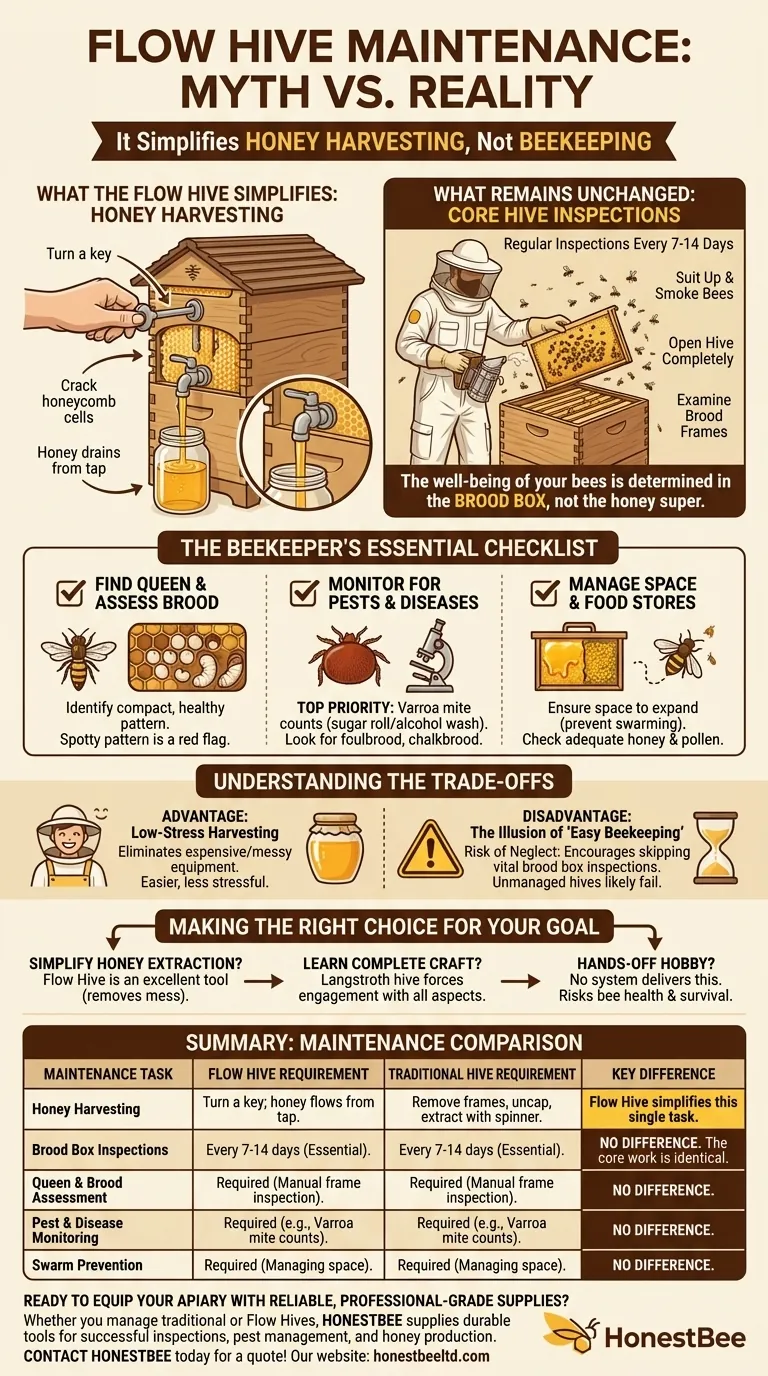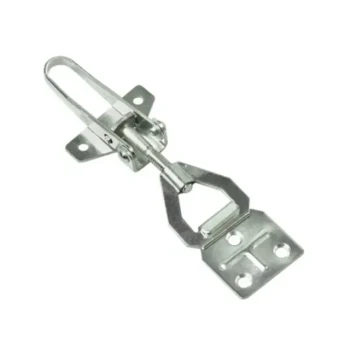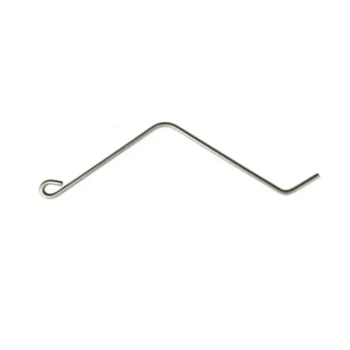In short, a Flow Hive requires the same fundamental maintenance and regular inspections as any standard beehive. The core tasks of beekeeping—ensuring the health and productivity of the colony—remain unchanged. The primary difference is confined to the specific process of harvesting honey.
The central misunderstanding about the Flow Hive is that it simplifies beekeeping. In reality, it simplifies honey harvesting. The essential, non-negotiable work of managing a healthy colony is identical to that of a traditional Langstroth hive.

The Reality of Flow Hive Maintenance
Many new beekeepers are drawn to the Flow Hive's innovative design, believing it removes the most difficult parts of the hobby. It's crucial to separate the task it simplifies from the core responsibilities that remain.
What the Flow Hive Simplifies: Honey Harvesting
The genius of the Flow Hive is its mechanism for honey extraction. By turning a key, you crack the honeycomb cells within the plastic Flow Frames, allowing honey to drain out via a tap.
This process replaces the traditional, labor-intensive method which involves removing frames, cutting wax cappings, and using a centrifugal extractor to spin out the honey. The Flow Hive makes this single event cleaner and less disruptive to the bees in the honey super.
What Remains Unchanged: Core Hive Inspections
The well-being of your bees is determined in the brood box, not the honey super. A responsible beekeeper must perform regular inspections every 7 to 14 days, regardless of hive type.
These inspections are critical for colony health and involve suiting up, smoking the bees, and opening the hive completely. You must still pull out and examine the frames in the brood box to assess the colony.
The Beekeeper's Essential Checklist
During a standard inspection of any hive, including a Flow Hive, you are looking for the same vital signs. The Flow Frames do not provide any information about these critical health indicators.
Finding the Queen and Assessing Brood
You must physically locate the queen or see evidence of her work. This means identifying a compact, healthy brood pattern with eggs, larvae, and capped pupae. A spotty pattern or a missing queen is an immediate red flag.
Monitoring for Pests and Diseases
Your top priority is checking for the Varroa destructor mite, the single greatest threat to honey bees. This requires performing a mite count (e.g., a sugar roll or alcohol wash). You also need to look for signs of other diseases like foulbrood or chalkbrood.
Managing Space and Food Stores
You must ensure the bees have enough space to expand their population to prevent swarming. Conversely, you also need to make sure they have adequate honey and pollen stores to survive periods of nectar dearth or winter.
Understanding the Trade-offs
The Flow Hive is a specialized tool, and like any tool, it comes with distinct advantages and disadvantages.
The Advantage: Low-Stress Harvesting
The key benefit is undeniable. It eliminates the need for expensive and messy extraction equipment, making the harvest itself significantly easier and less stressful for the beekeeper.
The Disadvantage: The Illusion of "Easy Beekeeping"
The most significant pitfall is that the "set-it-and-forget-it" marketing can give beginners a dangerously false sense of security. It can lead new beekeepers to believe their only job is to turn a tap for honey.
The Risk of Neglect
Because the most rewarding event (harvesting) is so easy, it can inadvertently encourage the neglect of the most important work: the difficult, regular brood box inspections. An unmanaged hive is highly likely to fail.
Making the Right Choice for Your Goal
To decide if a Flow Hive is right for you, honestly assess your primary motivation for getting into beekeeping.
- If your primary focus is to simplify the honey extraction process: The Flow Hive is an excellent tool that removes the need for a separate extractor and the associated mess.
- If your primary focus is to learn the complete craft of beekeeping: A traditional Langstroth hive forces you to engage with every aspect of the process, which can make you a more well-rounded beekeeper.
- If you believe beekeeping can be a hands-off hobby: No hive system can deliver this, and you risk the health and survival of your bees.
Ultimately, the Flow Hive is a unique tool for harvesting honey, not a substitute for the essential, hands-on work of responsible beekeeping.
Summary Table:
| Maintenance Task | Flow Hive Requirement | Traditional Hive Requirement | Key Difference |
|---|---|---|---|
| Honey Harvesting | Turn a key; honey flows from tap. | Remove frames, uncap, extract with spinner. | Flow Hive simplifies this single task. |
| Brood Box Inspections | Every 7-14 days (Essential). | Every 7-14 days (Essential). | No difference. The core work is identical. |
| Queen & Brood Assessment | Required (Manual frame inspection). | Required (Manual frame inspection). | No difference. |
| Pest & Disease Monitoring | Required (e.g., Varroa mite counts). | Required (e.g., Varroa mite counts). | No difference. |
| Swarm Prevention | Required (Managing space in brood box). | Required (Managing space in brood box). | No difference. |
Ready to equip your apiary with reliable, professional-grade supplies? Whether you manage traditional Langstroth hives or innovative Flow Hives, the fundamentals of beekeeping demand high-quality equipment. HONESTBEE supplies commercial apiaries and beekeeping equipment distributors with the durable tools needed for successful hive inspections, pest management, and honey production. Let's discuss your wholesale needs and ensure your operation is built to last. Contact HONESTBEE today for a quote!
Visual Guide

Related Products
- Automatic Honey Flow Beehive 4 Frame Mini Hive for Beekeeping
- HONESTBEE Professional Long Handled Hive Tool with Precision Cutting Blade
- HONESTBEE Advanced Ergonomic Stainless Steel Hive Tool for Beekeeping
- Professional Dual-End Stainless Steel Hive Tool for Beekeeping
- Professional Galvanized Hive Strap with Secure Locking Buckle for Beekeeping
People Also Ask
- How to extract honey in Flow Hives? Experience the Simplicity of Honey on Tap
- How does the Flow Hive simplify honey harvesting? The Revolutionary 'Honey on Tap' System Explained
- What are the benefits of using the Flow Hive for honey harvesting? Simplify Your Harvest & Protect Your Bees
- What is the selling point of the Flow Hive? A Revolutionary, Stress-Free Honey Harvest
- What are the advantages of using a Flow Hive? Simplifying Harvesting for Modern Beekeepers



















